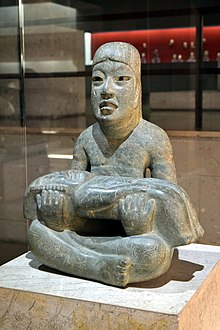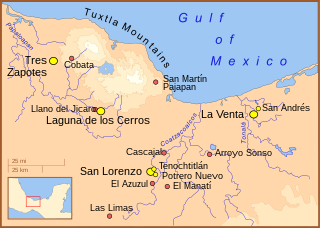
The Olmecs were the earliest known major Mesoamerican civilization. Following a progressive development in Soconusco, they occupied the tropical lowlands of the modern-day Mexican states of Veracruz and Tabasco. It has been speculated that the Olmecs derived in part from the neighboring Mokaya or Mixe–Zoque cultures.

Jade is a mineral used as jewellery or for ornaments. It is typically green, although may be yellow or white. Jade can refer to either of two different silicate minerals: nephrite, or jadeite.

Olmec figurines are archetypical figurines produced by the Formative Period inhabitants of Mesoamerica. While not all of these figurines were produced in the Olmec heartland, they bear the hallmarks and motifs of Olmec culture. While the extent of Olmec control over the areas beyond their heartland is not yet known, Formative Period figurines with Olmec motifs were widespread in the centuries from 1000 to 500 BC, showing a consistency of style and subject throughout nearly all of Mesoamerica.

Jadeite is a pyroxene mineral with composition NaAlSi2O6. It is hard (Mohs hardness of about 6.5 to 7.0), very tough, and dense, with a specific gravity of about 3.4. It is found in a wide range of colors, but is most often found in shades of green or white. Jadeite is formed only in the subduction zones of continental margins, where rock undergoes metamorphism at high pressure but relatively low temperature.

Nephrite is a variety of the calcium, magnesium, and iron-rich amphibole minerals tremolite or actinolite (aggregates of which also make up one form of asbestos). The chemical formula for nephrite is Ca2(Mg, Fe)5Si8O22(OH)2. It is one of two different mineral species called jade. The other mineral species known as jade is jadeite, which is a variety of pyroxene. While nephrite jade possesses mainly grays and greens (and occasionally yellows, browns, black or whites), jadeite jade, which is rarer, can also contain blacks, reds, pinks and violets. Nephrite jade is an ornamental stone used in carvings, beads, or cabochon cut gemstones. Nephrite is also the official state mineral of Wyoming.

The mere is a type of short, broad-bladed weapon in the shape of an enlarged tear drop. It was used to strike/jab an opponent in the body or the head, usually made from nephrite jade. A mere is one of the traditional, hand to hand, one-handed weapons of the indigenous Māori of New Zealand, and a symbol of chieftainship.

The tradition of Korean jade carving dates back to neolithic finds along the Namgang river basin in Gyeongju. Jade rings and accessories made from both nephrite and jadeite were worn by the higher classes of society, especially women, from the three kingdoms period and reached their peak in the Joseon dynasty, the golden age of jadework. Carved jade artifacts found in Silla dynasty tombs appear to be made from jade originating from Japan and Taiwan, suggested sea trade of jade existed prior to the 5th century AD. Korean jadework often includes Buddhist motifs, cicadas, and small peanut-shaped or comma-shaped good luck talismans, as well as larger-scale architectural pieces. A gold crown featuring 58 hanging jade pendants and a gold girdle with 13 jade pendants were both found in the Silla-era tomb of an unknown king, called Cheonmachong, first excavated in 1973.
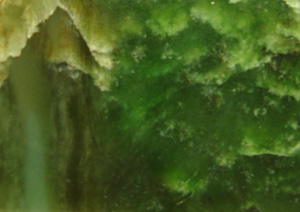
Bowenite is a hard, compact variety of the serpentinite species antigorite, (Mg3(OH)O4Si2O5). Classed as semi-precious gemstone it has been used for tools, weapons and jewellery by the Māori in New Zealand, and for jewellery by Fabergé. Deposits are found in several places around the world including Afghanistan, China, New Zealand, South Africa and the United States. It typically ranges in colour from dark green to light olive green, and in shades approaching yellow. Bowenite was named by James D. Dana in 1850 after George T. Bowen, who analyzed it in 1822.

The use of jade in Mesoamerica for symbolic and ideological ritual was highly influenced by its rarity and value among pre-Columbian Mesoamerican cultures, such as the Olmec, the Maya, and the various groups in the Valley of Mexico. Although jade artifacts have been created and prized by many Mesoamerican peoples, the Motagua River valley in Guatemala was previously thought to be the sole source of jadeite in the region.

Jadeite is presumed one of the most precious materials of Pre-Columbian Costa Rica. It, along with other similar-looking greenstones were cherished and worked for years. Jadeite was used to decorate the body and was presumably a symbol of power.

Jadeitite is a metamorphic rock found in blueschist-grade metamorphic terranes. It is found in isolated metasomatically altered rock units within serpentinite associated with subduction zone environments. Jadeitite consists almost entirely of the pyroxene mineral jadeite and is typically mined as a source of the ornamental rock or gemstone, jade. Occurrences include Myanmar, Guatemala, Japan, Kazakhstan and in the Coast Ranges of western North America.

Chinese jade refers to the jade mined or carved in China from the Neolithic onward. It is the primary hardstone of Chinese sculpture. Although deep and bright green jadeite is better known in Europe, for most of China's history, jade has come in a variety of colors and white "mutton-fat" nephrite was the most highly praised and prized. Native sources in Henan and along the Yangtze were exploited since prehistoric times and have largely been exhausted; most Chinese jade today is extracted from the northwestern province of Xinjiang.
Sierra de las Minas is a mountain range in eastern Guatemala, extending 130 km west of the Lake Izabal. It is 15–30 km wide and bordered by the valleys of the rivers Polochic in the north and the Motagua in the south. Its western border is marked by the Salamá River valley which separates it from the Chuacús mountain range. The highest peak is Cerro Raxón at 3,015 m. The Sierra's rich deposits of jade and marble have been mined throughout the past centuries. These small scale mining activities also explain the name of the mountain range.
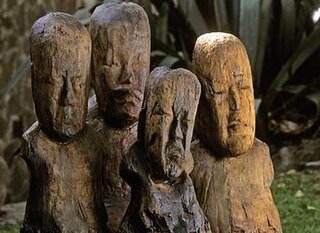
El Manatí is an archaeological site located approximately 60 km south of Coatzacoalcos, in the municipality of Hidalgotitlán 27 kilometers southeast of Minatitlán in the Mexican state of Veracruz. El Manatí was the site of a sacred Olmec sacrificial bog from roughly 1600 BCE until 1200 BCE.

The Wairau Bar, or Te Pokohiwi, is a 19-hectare (47-acre) gravel bar formed where the Wairau River meets the sea in Cloudy Bay, Marlborough, north-eastern South Island, New Zealand. It is an important archaeological site, settled by explorers from East Polynesia who arrived in New Zealand about 1280. It is one of the earliest known human settlements in New Zealand. At the time of the occupation it is believed to have been a low scrub-covered island 2 to 3 metres high, 1.1 kilometres (0.68 mi) long and 0.4 kilometres (0.25 mi) wide.
Olmec hieroglyphs designate a possible system of writing or proto-writing developed within the Olmec culture. The Olmecs were the earliest known major Mesoamerican civilization, flourishing during the formative period in the tropical lowlands of the modern-day Mexican states of Veracruz and Tabasco. The subsequent Epi-Olmec culture, was a successor culture to the Olmec and featured a full-fledged writing system, the Isthmian script.

Hardstone carving, in art history and archaeology, is the artistic carving of semi-precious stones, such as jade, rock crystal, agate, onyx, jasper, serpentinite, or carnelian, and for objects made in this way. Normally the objects are small, and the category overlaps with both jewellery and sculpture. Hardstone carving is sometimes referred to by the Italian term pietre dure; however, pietra dura is the common term used for stone inlay work, which causes some confusion.
Prehistoric technology is technology that predates recorded history. History is the study of the past using written records. Anything prior to the first written accounts of history is prehistoric, including earlier technologies. About 2.5 million years before writing was developed, technology began with the earliest hominids who used stone tools, which they first used to hunt food, and later to cook.
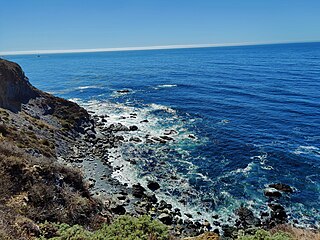
Jade Cove is located in the southern area of Big Sur on the California central coast. It contains the only concentrated underwater deposit of quality nephrite jade in the world. Individuals are permitted to collect as much jade as they can personally carry using hand tools up to 90 feet (27 m) deep offshore.

Pounamu is a term for several types of hard and durable stone found in southern New Zealand. They are highly valued in New Zealand, and carvings made from pounamu play an important role in Māori culture.
